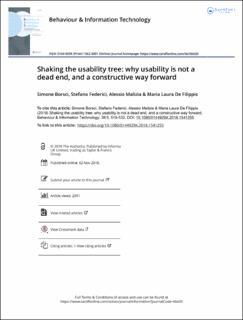| dc.contributor.author | Borsci, Simone | |
| dc.contributor.author | Federici, Stefano | |
| dc.contributor.author | Malizia, Alessio | |
| dc.contributor.author | De Filippis, Maria Laura | |
| dc.date.accessioned | 2023-07-06T11:12:37Z | |
| dc.date.available | 2023-07-06T11:12:37Z | |
| dc.date.created | 2018-11-12T09:29:43Z | |
| dc.date.issued | 2019 | |
| dc.identifier.citation | Behaviour and Information Technology. 2019, 38 (5), 519-532. | en_US |
| dc.identifier.issn | 0144-929X | |
| dc.identifier.uri | https://hdl.handle.net/11250/3076561 | |
| dc.description.abstract | A recent contribution to the ongoing debate concerning the concept of usability and its measures proposed that usability reached a dead end – i.e. a construct unable to provide stable results and to unify scientific knowledge. Extensive commentaries rejected the conclusion that researchers need to look for alternative constructs to measure the quality of interaction. Nevertheless, several practitioners involved in this international debate asked for a constructive way to move forward the usability practice. In fact, two key issues of the usability field were identified in this debate: (i) knowledge fragmentation in the scientific community, and (ii) the unstable relationship among the usability metrics. We recognise both the importance and impact of these key issues, although, in line with others, we may not agree with the conclusion that the usability is a dead end. Under the light of the international debate, this work discusses the strengths and weaknesses of usability construct and its application. Our discussion focuses on identifying alternative explanations to the issues and to suggest mitigation strategies, which may be considered the starting point to move forward the usability field. However, scientific community actions will be needed to implement these mitigation strategies and to harmonise the usability practice. Keywords: human–machine interface, interaction design, ISO 9241-11, usability, usability factors, usability testing | en_US |
| dc.language.iso | eng | en_US |
| dc.relation.uri | https://doi.org/10.1080/0144929X.2018.1541255 | |
| dc.rights | Attribution-NonCommercial-NoDerivatives 4.0 Internasjonal | * |
| dc.rights.uri | http://creativecommons.org/licenses/by-nc-nd/4.0/deed.no | * |
| dc.title | Shaking the usability tree : why usability is not a dead end, and a constructive way forward | en_US |
| dc.type | Peer reviewed | en_US |
| dc.type | Journal article | en_US |
| dc.description.version | publishedVersion | en_US |
| dc.source.pagenumber | 519-532 | en_US |
| dc.source.volume | 38 | en_US |
| dc.source.journal | Behaviour and Information Technology | en_US |
| dc.source.issue | 5 | en_US |
| dc.identifier.doi | 10.1080/0144929X.2018.1541255 | |
| dc.identifier.cristin | 1629211 | |
| cristin.ispublished | true | |
| cristin.fulltext | original | |
| cristin.qualitycode | 1 | |

